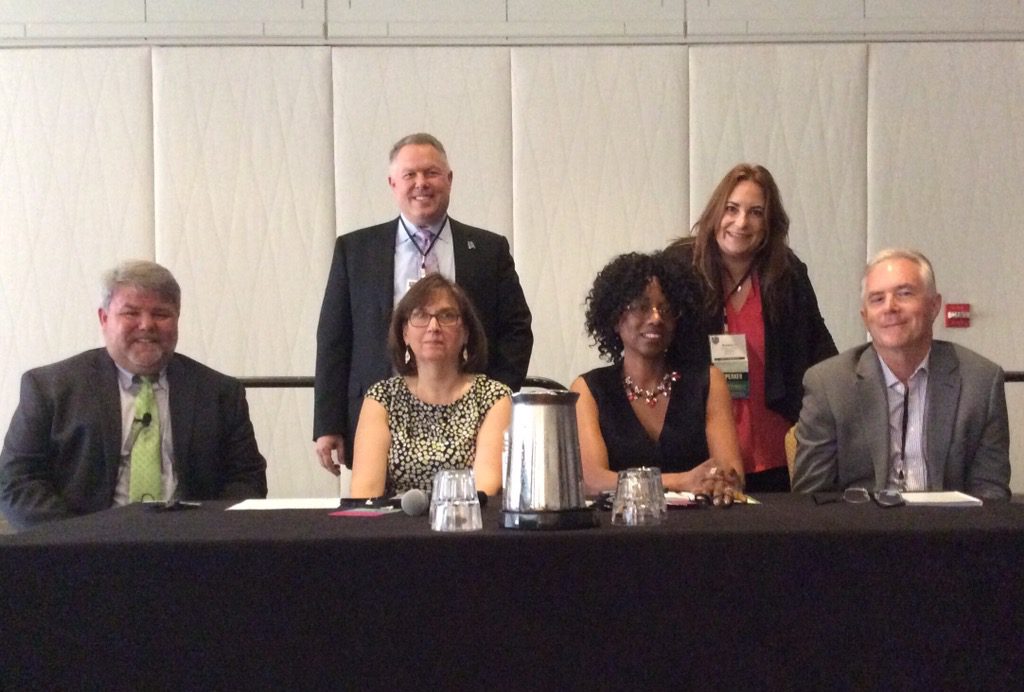Addressing Municipalities’ Workers’ Compensation Challenges
This session at the PRIMA 2016 Annual Conference featured a panel of public entity risk managers discussing their biggest workers’ compensation challenges and how they are overcoming them.
Presenters included:
- Mark Walls, Safety National
- Kimberly George, Sedgwick Claims Management Services, Inc.
- Marilyn Rivers, CPCU, ARM, AIC, City Saratoga Springs, NY
- Dan Hurley, CSP, ARM-P, MS, City of Chesapeake, VA
- Wade Damron, Georgia Department of Administrative Services
- Dawn Watkins, AIC, PHR, ARM-P, Los Angeles Unified School District
What are some return to workers’ comp challenges you experience and how have you approached them?
Rivers: We are in a unique situation, so we created a 19-member safety committee. On it, 10 of the positions are union spots. Every month it is expected for the unions to come and discuss their injury issues, concerns about health and safety, workers’ comp issues, etc. We use it as an opportunity to communicate and strategize. For example, we had a high incidence of back injuries with fire fighters due to the use of old stretchers that required a lot of lifting. We petitioned for money to updated our stretchers to motorized stryker stretchers to help decrease the amount of these claims. We have also installed cameras on certain streets so that police officers can point to them, which has eliminated the large amount of altercations leading to injuries that were occurring. Our approach is to try to reduce the amount of injuries before they occur.
Watkins: We work closely with our labor partners, however, they are opposed to us putting workers in different positions for return to work with modified duty. That is limiting. Also many have the perception that employees have to be 100% to return to work, which is not accurate, so we are trying to change that internally.
Hurley: We had a problem with low-skill labor areas not having modified duty jobs available. We worked with departments to create a modified duty job list so we can identify opportunities. This included clerical, greeting and observational work. Our HR department has also evaluated what activities are associated with which job descriptions, so we can use the checklist to ensure the person can perform the modified duty tasks.
Damron: We have targeted the agencies that have the highest amount of injuries. With the help of our occupational therapy partners, we evaluated activity analysis for job descriptions for light duty jobs. We also have instituted a type of job-sharing process between counties.
How do you work with your third-party administrator (TPA) and other partners on claims management issues?
Hurley: It’s important to have a nurse case manager that will find what is sticking in the case and move it along. When they know the doctors, they can intervene and have a positive influence on keeping the process going. Also, if you have physical therapist that will go out to the work site to find solutions to equipment, for example, to get your employee back to work. Usually, it’s a small tweak like a work bench with more back support that can solve your problem.
Rivers: I think in hard-core cases, if you look at it with a more holistic approach, you see that there are psychological issues holding up a case. I had a case of a police officer with a bad knee. I found out that he wanted to come back to work, but was afraid that he would injure his knee again. We provided some psychological support and, by capitalizing on the word “afraid” in his case notes, we were able to overcome it. He is now a very productive member of the force.
Watkins: I find this to be the case as well. You have to look at your claims with new eyes. Many drivers are outside of the normal guidelines and you have to find those red flags. Outside of that, we also visit our medical clinics and meet with the doctors to do a quality assurance check. Time off work is often medically driven.
Damron: We work very closely with our TPA. We get the examiners into our locations and train them to understand all of the differences we face at our different agencies. We spend a lot of time making sure that they understand our expectations.
Watkins: I have constant engagement with our TPA. I want my employees treated well but also want the detection of fraud. We review claims often and have created a task-force approach for trending problems. My customer service liaison is probably the best contact I have. Their job is to make sure the “customers” (i.e. the employee and their employer) are communicated to and satisfied. This is yielding many benefits because an employee that feels cared for will often return to work more quickly.


